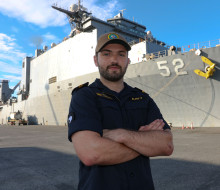
Kiwi officer embedded in Pacific Partnership
07 August 2025
Unfortunately you are viewing this website on an outdated browser which does not support the necessary features for us to provide an adequate experience. Please switch to a modern browser such as latest version of Google Chrome, Mozilla Firefox, Apple Safari or Microsoft Edge.
Ngā mihi nui
Commander Andy Grant, Executive Officer HMNZS Te Kaha, gives an insight into the complexities of refuelling while on task in the Arabian Gulf.
We have a RAS tomorrow.
It’s a frequent topic of conversation aboard HMNZS Te Kaha today. It stands for Replenishment At Sea and we pronounce it as ‘Razz’. It’s how we refuel at sea.
Down in the darkened Operations Room, an Electronic Warfare specialist moves away from the dimly glowing screens and studies a well-thumbed copy of Jane’s Fighting Ships. Editions of this book have been in print for more than 100 years, with the images and details of every warship in the world, and it’s one of the few we still have in hard copy.
He finds the page for USNS Guadalupe. It’s a Henry J Kaiser class replenishment oiler, 206 metres in length, commissioned in 1992. This will be our floating gas station. We sent our fuel order by signal several days ago, and have received a reply detailing Guadalupe as our tanker and a designated rendezvous.
Meanwhile, in the Charthouse, the Navigator (Navs) has found the online Allied Tactical Publication that gives detailed information on where the refuelling facilities are onboard Guadalupe, what fuels, she has, and the methods for transfer. We need 20 cubic metres of aviation fuel, and 70 cubic metres of ship fuel.
In the Machinery Control Room, the engineers are looking through the fuelling schematics and recalling all the pipework, tanks and valves in between. To make the transfer straightforward they will need to transfer fuel to other tanks, so they can take the new fuel into a tank with sufficient capacity…and perhaps a little more.
In his tiny office, the Chief Bosun’s Mate (the Buffer) ponders the evolution team and puts names to each position – ensuring that there is suitable experience and supervision in all areas. This is critical work. When things go wrong, it happens quickly, and the consequences can be dire for our people, the ship, and the environment.
The Commanding Officer (CO), Navs and I have an initial brief in the Commanding Officer’s cabin, to go over the main aspects of the RAS. We’re looking at participants, forecast conditions and the general line-up of their fuel-supply position with our fuel-receive position.
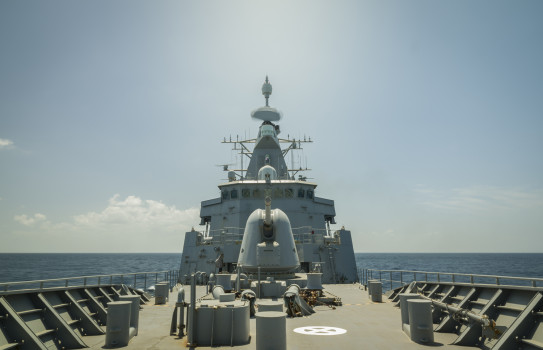
HMNZS Te Kaha on patrol.
From here, we can work-out the finer details of the manoeuvre to drive a 3,600-tonne frigate to a position 45 metres abreast of a 41,000 tonne tanker and hold it there for two hours.
We all come together for a formal RAS Brief later in the day. After an overview, each area gives a detailed brief on their specific role. Navs and Comms look after the manoeuvre. The Buffer handles seamanship. The ship’s Marine Engineer looks after fuelling. The Weapons Engineer takes equipment preparations and any relevant defects.
As the Executive Officer (XO), I review ‘Overall Safety, Risks and Mitigations’. Questions are asked, the ‘Safe Sailor’ policy is recited and the team step away knowing that all is in hand for tomorrow morning.
For the last two days we’d been tracking Gaudalupe’s location, and you would think that the actual rendezvous would seem mundane. But there’s still a little bit of magic when the tanker is sighted in the morning, steaming up over the horizon.
After a couple of hiccups with radio comms, an American voice comes though the speaker clearly – passing a coded message to take charge of us for the RAS, and assigning us an initial station one nautical mile on the Tanker’s beam. We move there promptly. Taking up your ‘assigned station’ is a manoeuvre that all navies judge each other’s performance on. We don’t want to let ourselves and our ship down.
Once in station we have a clear view of the Guadalupe. Like us, she wears some rust streaks from time at sea, but the overall impression is that she is big and purposeful. It is time to pipe RAS Special Sea Dutymen over the main broadcast system. This is the call that goes throughout the ship to send personnel to their assigned stations for the RAS. Personnel start to stream out onto the upper-deck, many with the coloured vests that indicate their role. They wear hard-hats and have protective goggles, safeguards in case the fuelling system springs a leak under pressure.
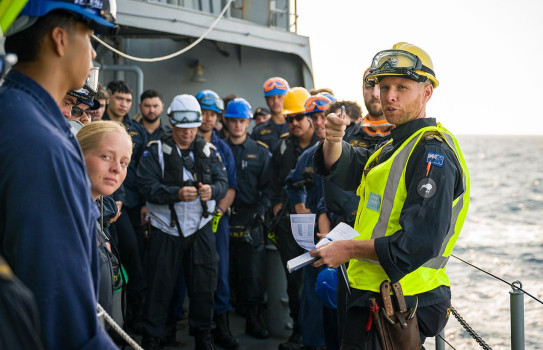
A final briefing to Te Kaha’s RAS party as the ship prepares to come alongside Guadalupe.
The final ropes are laid-out and preparations made. We constrain our electronic transmissions to ensure we don’t radiate our people on the deck; or unwittingly, interfere with any electronic systems in Guadalupe.
On the bridge the Assistant Officer of the Watch is taking in all the reports from around the Ship and ticking-off the RAS Preparations checklist. ‘Aft Steering’ call in. This is a team of two that are situated in a machinery compartment right on top of the ships’ rudder. They are there to take immediate actions to regain steering if something goes wrong with steering from the bridge. When you are 45m from another ship, every second counts.
With all preparations made, Guadalupe orders us into ‘waiting station’. Just as it sounds, this is the station close-astern of the tanker where we get lined-up before making the final run-in to the alongside refuelling position. The Officer of the Watch takes the ship to waiting station, before handing the ship over to the CO. It is a short wait before the ship is called in to RAS.
The manoeuvre we use is called a fast back-down. Basically, we line up behind the tanker with a 45-metre offset to starboard, then accelerate to maximum speed. We then do a dramatic speed reduction to decelerate to be in just the right spot with our speed perfectly matched with the tanker.
It goes well and the CO only needs to make some minor adjustments to get us in place. We can now see the faces of our counterparts in Guadalupe. There are some friendly waves and we recognise our opposite numbers by the colours of the vests that they wear.
While this is happening, I give the Buffer the thumbs-up and there are three blasts on a whistle from Te Kaha, with a two-blast response from Guadalupe.
A loud bang, and two projectiles stream out from Te Kaha carrying thin lines across to Guadalupe. They entangled in some of Guadalupe’s cranes and rigging, but the deck team over there have seen this all before. They quickly wrangle the lines out of the rigging and into the hands of their deck teams below.
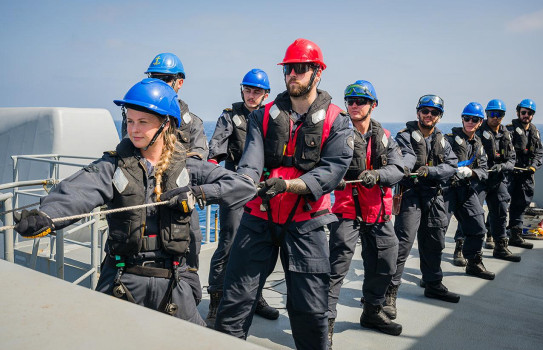
The RAS team aboard Te Kaha take up the passing of the lines that will ultimately support the fueling lines between the two ships.
‘Batman’ steps up. Not the caped crusader, but a person on each ship that uses coloured bats to signal and synchronise the passing of the lines. First the thin initial lines, then increasingly thicker lines until the final steel spanwire is passed that will carry the fuelling hose and probe connector.
Our Batman is the ship’s Master at Arms, the Naval Policewoman. She is situated above the RAS point in plain view, and she and her counterpart in Guadalupe exchange signals that choreograph the lines that join the ships together. Up forward, just ahead of the Bridge a ‘Distance Line’ is passed with a telephone line. The Distance Line has coloured flags every six metres. When hauled taught between the ships, it provides a ready-reference to measure distance apart.
With the spanwire across and connected, Guadalupe tensions the wire, before sending the probe down the spanwire to finally connect into Te Kaha’s probe receiver. It mates perfectly first time and we are ready to receive the Ship Fuel. Under the main hoseline, a smaller hose carries the Aviation Fuel. This is manually connected up by the engineers and fuel begins to flow.
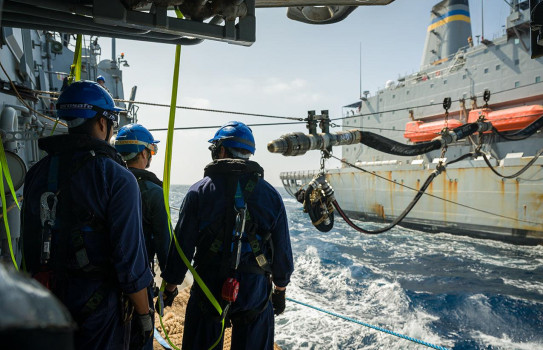
The ship fuel line and the smaller aviation fuel line are pulled across for Guadalupe.
The pressure is off a bit, but the vigilance and the focus remains. Thirty minutes have now passed and Te Kaha is ‘in the groove’, only needing minor adjustments of speed and heading to remain within three to four metres of the ideal position. Navs takes over from the CO, to give her a break from concentration. Reports on the fuelling progress suggest there is another 45 minutes to go.
It passes quickly. ‘Stop pumping’ is called and you can see the hoses flatten as they lose pressure and drain the last of the fuel. The fuelling rig is decoupled and retracted by Guadalupe, as coordinated by the Batman.
The distance line is the last to go and with the ‘bitter end’ finally dropped into the sea, Te Kaha is unleashed and moves away from Guadalupe. Cautiously at first, before the order is given to increase speed and continue to veer away. Personnel below decks can hear the turbos spool up on the engines, and know that we are breaking away. The ship heels over as we continue our high-speed turn, making a majestic sweep to pass astern of Guadalupe to head off in search of our next drug-runner. In the various areas, notes are being made. What went well? What went wrong, and what can we do better?
From the bridge we exchange final comms with our American friend.
“Fair winds and following seas… see you next time.”
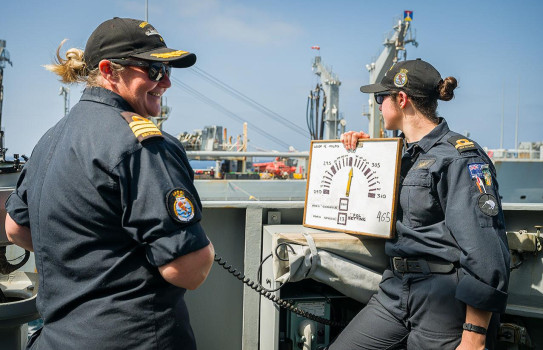
CDR Fiona Jameson, Commanding Officer Te Kaha, monitors progress and calls for course and speed adjustments if necessary.